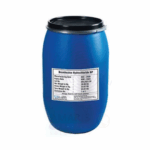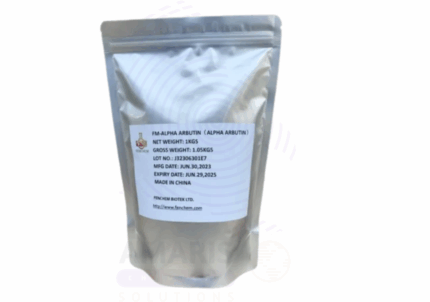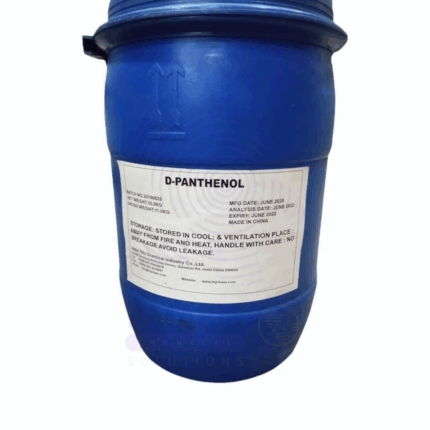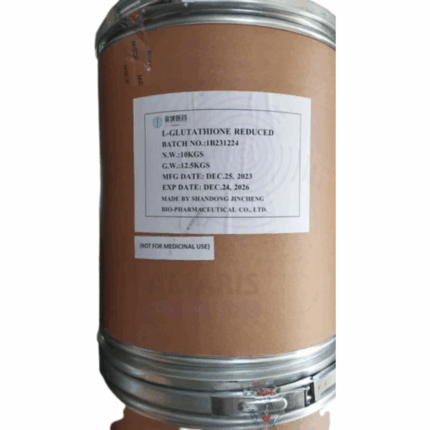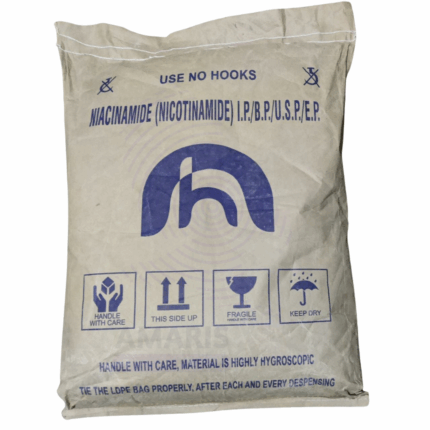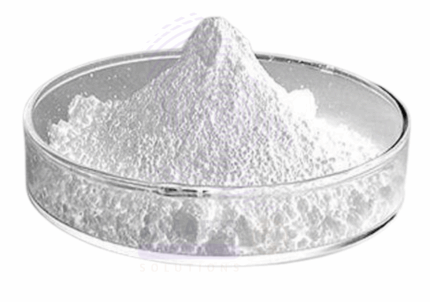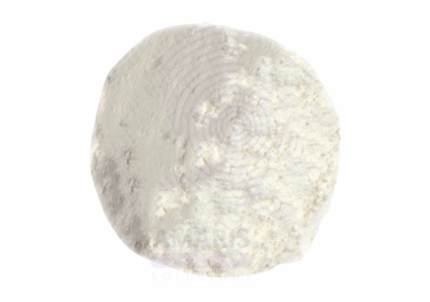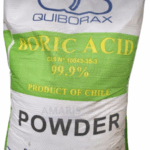
Boric Acid
$ 3.14 Original price was: $ 3.14.$ 3.03Current price is: $ 3.03.
Bromelain
Whatsapp Order
Bromelain is a natural mixture of proteolytic enzymes derived primarily from the stem and fruit of the pineapple plant (Ananas comosus). It appears as a pale yellow to off-white powder with a characteristic mild odor and is water-soluble. Bromelain exhibits protease activity, breaking down proteins into peptides and amino acids, making it valuable in medical, food, and industrial applications. It is widely used as an anti-inflammatory agent, digestive aid, meat tenderizer, and in cosmetic formulations due to its enzymatic and therapeutic properties.
Description
Table of Contents
Toggle
Bromelain
Primary Uses
- Pharmaceuticals & Therapeutics
- Used as an anti-inflammatory and analgesic agent to reduce swelling and pain associated with injuries, surgeries, and osteoarthritis.
- Incorporated in digestive enzyme supplements to aid protein digestion and support gastrointestinal health.
- Utilized to improve wound healing and reduce tissue inflammation.
- Food Industry
- Used as a meat tenderizer due to its ability to hydrolyze tough protein fibers.
- Added to brewing and baking processes to improve clarity and texture by breaking down proteins.
- Cosmetics & Personal Care
- Included in exfoliating and skin care products for its ability to gently remove dead skin cells and improve skin texture.
- Used in formulations aimed at reducing inflammation and promoting skin healing.
- Industrial Applications
- Employed in the production of protein hydrolysates and flavor enhancers.
- Used in textile and leather industries for dehairing and softening.
Secondary Uses
- Oral Care
- Incorporated in some dental products for plaque reduction and gum inflammation control.
- Veterinary Medicine
- Used as a digestive aid and anti-inflammatory agent in animals.
- Research & Biotechnology
- Utilized as a biochemical tool for protein digestion and cell dissociation in laboratory settings.
KEY PRODUCT FEATURES
1. Basic Identification Attributes
- Chemical Name (IUPAC): Protease enzyme from Ananas comosus
- Common/Trade Name: Bromelain
- CAS Number: 9001-00-7 (commercial enzyme preparation)
- HS Code: 3507.90.00
- Molecular Formula: Mixture of proteolytic enzymes (variable)
- Synonyms:
- Pineapple protease
- Ananas protease
- Stem bromelain
2. Physical & Chemical Properties
- Physical State: Powder or granules
- Color & Odor: Pale yellow to off-white; mild characteristic odor
- Melting Point: Not applicable (enzyme denatures at ~50-60°C)
- Boiling Point: Not applicable
- Density: Varies, typically low bulk density (~0.3-0.6 g/cm³)
- Solubility: Soluble in water; insoluble in organic solvents
- pH Range: Active in pH 4.0–9.0; optimum activity around pH 6.0–7.0
- Temperature Stability: Active up to ~50°C; denatures at higher temperatures
- Stability: Sensitive to heat, extreme pH, and protease inhibitors
3. Safety & Hazard Attributes
- Hazard Class (GHS): Not classified as hazardous but may cause allergic reactions in sensitive individuals
- NFPA Ratings:
- Health: 1 (mild irritant)
- Flammability: 0
- Reactivity: 0
- Exposure Limits: No specific OSHA/ACGIH limits; avoid inhalation of dust
- Toxicity: Low toxicity; potential allergen
- Reactivity: Enzymatic activity can be inhibited by specific chemicals and temperature extremes
4. Storage & Handling Attributes
- Storage Conditions: Store in a cool, dry place, preferably refrigerated (2–8°C) to maintain enzyme activity
- Container Type: Airtight, moisture-proof containers (e.g., vacuum-sealed bags or HDPE jars)
- Shelf Life: Typically 1–2 years under proper storage conditions
- Special Handling: Avoid moisture and heat exposure; use PPE to avoid respiratory sensitization
5. Regulatory & Compliance Attributes
- FDA Status: Generally recognized as safe (GRAS) for use in food and supplements
- Pharmacopoeia Compliance: Included in some pharmacopeias for enzyme preparations
- Transportation: Not classified as hazardous
- Waste Disposal: Non-hazardous; dispose of according to local regulations
6. Environmental & Health Impact
- Ecotoxicity: Low; biodegradable enzyme protein
- Persistence: Biodegrades naturally in the environment
- Bioaccumulation: Not expected to bioaccumulate
- Carcinogenicity/Mutagenicity: Not classified as carcinogenic or mutagenic
- Biodegradability: Readily biodegradable
SAFETY HANDLING PRECAUTIONS
Safety Handling Precautions
Personal Protective Equipment (PPE):
- Gloves
- Protective goggles
- Dust mask or respirator (to prevent inhalation of powder)
- Lab coat or protective clothing
Handling Measures:
- Avoid inhalation of dust
- Handle in well-ventilated areas
- Prevent moisture contact to preserve enzyme activity
Storage Measures:
- Keep container tightly closed
- Protect from heat and humidity
Hygiene Practices:
- Wash hands thoroughly after handling
- Do not eat, drink, or smoke during handling
First Aid Measures
- Inhalation: Move to fresh air; seek medical advice if respiratory irritation or allergic symptoms develop
- Skin Contact: Wash affected area with soap and water; seek medical attention if irritation occurs
- Eye Contact: Rinse eyes thoroughly with water for at least 15 minutes; seek medical attention if irritation persists
- Ingestion: Rinse mouth with water; seek medical attention if large quantities ingested or symptoms occur
Firefighting Measures
- Fire Hazards: Non-flammable
- Extinguishing Media: Use water spray, foam, dry chemical, or CO₂ as appropriate for surrounding fire
- Special Precautions: Firefighters should wear protective gear; bromelain itself does not pose fire hazard
- Decomposition Products: May emit nitrogen oxides or other organic compounds if exposed to extreme heat
Related products
Alpha Arbutin
Alpha Arbutin is a biosynthetic active ingredient derived from hydroquinone and glucose. It is widely used in cosmetic and skincare formulations for its skin-brightening and spot-reducing properties. Alpha Arbutin inhibits tyrosinase, an enzyme involved in melanin production, thereby helping to reduce pigmentation, dark spots, and uneven skin tone. It is more stable and effective than its beta counterpart and is suitable for all skin types, including sensitive skin.
D-Panthenol USP
D-Panthenol USP, also known as Provitamin B5, is the dextrorotatory isomer of panthenol and is biologically active. It is a water-soluble, viscous, clear liquid with a slightly sweet odor and is widely used in pharmaceutical, cosmetic, personal care, and nutraceutical applications. D-Panthenol is the alcohol analog of pantothenic acid (Vitamin B5) and is converted into Vitamin B5 in the skin and body, where it plays a vital role in cellular metabolism and tissue repair. Its moisturizing, anti-inflammatory, and healing properties make it highly valuable across industries.
Folic Acid
Folic Acid, also known as Vitamin B9 or pteroylmonoglutamic acid, is a water-soluble vitamin essential for numerous physiological processes including DNA synthesis, repair, and methylation, as well as amino acid metabolism. It appears as a yellow to orange-yellow crystalline powder, odorless or with a faint characteristic odor. Folic Acid is vital for cell division and growth, making it critical during pregnancy and periods of rapid growth. It is widely used in the pharmaceutical, nutraceutical, food fortification, and cosmetic industries due to its role in preventing folate deficiency anemia, neural tube defects in newborns, and supporting overall cellular health.
L-Glutathione Reduced
L-Glutathione Reduced is a tripeptide composed of glutamine, cysteine, and glycine, present in cells as a vital antioxidant. It appears as a white to off-white crystalline powder and plays a key role in protecting cells from oxidative stress by neutralizing free radicals and reactive oxygen species. Reduced glutathione (GSH) is the active form that participates in cellular detoxification, immune support, and regeneration of other antioxidants. It is widely used in pharmaceutical, cosmetic, and food industries due to its potent antioxidant properties and skin-brightening effects.
Marigold Seed Oil
Marigold Seed Oil is a cold-pressed oil extracted from the seeds of Calendula officinalis. It is known for its rich content of carotenoids, vitamin E, and essential fatty acids. This oil has a light, nutty aroma and a golden-yellow color. It is prized for its soothing, anti-inflammatory, and skin-conditioning properties. Marigold Seed Oil is widely used in cosmetic formulations, natural skincare products, and therapeutic balms.
Nicotinamide BP
Nicotinamide BP, also known as niacinamide, is a water-soluble form of vitamin B3 (niacin). It is a vital nutrient involved in numerous cellular processes, including energy metabolism, DNA repair, and antioxidant activity. Widely used in pharmaceutical, cosmetic, and nutritional applications, Nicotinamide supports skin health, improves barrier function, and exhibits anti-inflammatory properties. It is commonly found in dietary supplements, skincare formulations, and medical treatments for various dermatological conditions.
Prednisolone Base
Prednisolone Base is a synthetic glucocorticoid steroid widely used for its potent anti-inflammatory and immunosuppressive properties. It is the active form of prednisolone, commonly administered in various pharmaceutical formulations including tablets, injectables, and topical creams. This compound helps manage conditions involving inflammation, allergic reactions, and immune system disorders by modulating the body’s response to these processes.
Protease Baking Enzymes
Protease Baking Enzymes are specialized enzymes that catalyze the breakdown of proteins into peptides and amino acids. In baking, these enzymes improve dough handling, texture, and volume by modifying gluten structure and enhancing gas retention. They help produce softer crumb, better crust, and increased shelf life of baked goods. Protease enzymes are essential for consistent quality and efficiency in commercial baking operations.


 Preservatives(food)
Preservatives(food) Flavor Enhancers
Flavor Enhancers Acidulants
Acidulants Sweeteners
Sweeteners Antioxidants
Antioxidants Colorants(food)
Colorants(food) Nutraceutical Ingredients (food)
Nutraceutical Ingredients (food) Nutrient Supplements
Nutrient Supplements Emulsifiers
Emulsifiers
 Collectors
Collectors Dust Suppressants
Dust Suppressants Explosives and Blasting Agents
Explosives and Blasting Agents Flocculants and Coagulants
Flocculants and Coagulants Frothers
Frothers Leaching Agents
Leaching Agents pH Modifiers
pH Modifiers Precious Metal Extraction Agents
Precious Metal Extraction Agents
 Antioxidants(plastic)
Antioxidants(plastic) Colorants (Pigments, Dyes)
Colorants (Pigments, Dyes) Fillers and Reinforcements
Fillers and Reinforcements Flame Retardants
Flame Retardants Monomers
Monomers Plasticizers
Plasticizers Polymerization Initiators
Polymerization Initiators Stabilizers (UV, Heat)
Stabilizers (UV, Heat)
 Antifoaming Agents
Antifoaming Agents Chelating Agents
Chelating Agents Coagulants and Flocculants
Coagulants and Flocculants Corrosion Inhibitors
Corrosion Inhibitors Disinfectants and Biocides
Disinfectants and Biocides Oxidizing Agents
Oxidizing Agents pH Adjusters
pH Adjusters Scale Inhibitors( water)
Scale Inhibitors( water)
 Antioxidants(cosmetic)
Antioxidants(cosmetic) Emollients
Emollients Fragrances and Essential Oils
Fragrances and Essential Oils Humectants
Humectants Preservatives
Preservatives Surfactants(cosmetic)
Surfactants(cosmetic) Thickeners
Thickeners UV Filters
UV Filters
 Fertilizers
Fertilizers Soil Conditioners
Soil Conditioners Plant Growth Regulators
Plant Growth Regulators Animal Feed Additives
Animal Feed Additives Biostimulants
Biostimulants Pesticides (Herbicides, Insecticides, Fungicides)
Pesticides (Herbicides, Insecticides, Fungicides)
 Active Pharmaceutical Ingredients (APIs)
Active Pharmaceutical Ingredients (APIs) Excipients
Excipients Solvents(pharmaceutical)
Solvents(pharmaceutical) Antibiotics
Antibiotics Antiseptics and Disinfectants
Antiseptics and Disinfectants Vaccine Adjuvants
Vaccine Adjuvants Nutraceutical Ingredients (pharmaceutical)
Nutraceutical Ingredients (pharmaceutical) Analgesics & Antipyretics
Analgesics & Antipyretics
 Analytical Reagents
Analytical Reagents Solvents(lab)
Solvents(lab) Chromatography Chemicals
Chromatography Chemicals Spectroscopy Reagents
Spectroscopy Reagents microbiology-and-cell-culture-reagents
microbiology-and-cell-culture-reagents Molecular Biology Reagents
Molecular Biology Reagents Biochemical Reagents
Biochemical Reagents Inorganic and Organic Standards
Inorganic and Organic Standards Laboratory Safety Chemicals
Laboratory Safety Chemicals Specialty Laboratory Chemicals(Special Laboratory Equipment)
Specialty Laboratory Chemicals(Special Laboratory Equipment)
 Demulsifiers
Demulsifiers Hydraulic Fracturing Fluids
Hydraulic Fracturing Fluids Scale Inhibitors(oil)
Scale Inhibitors(oil) Surfactants(oil)
Surfactants(oil) Drilling Fluids
Drilling Fluids
 Dyes and Pigments
Dyes and Pigments Bleaching Agents
Bleaching Agents Softening Agents
Softening Agents Finishing Agents
Finishing Agents Antistatic Agents
Antistatic Agents
 Admixtures
Admixtures Waterproofing Agents
Waterproofing Agents Sealants and Adhesives
Sealants and Adhesives Curing Compounds
Curing Compounds Concrete Repair Chemicals
Concrete Repair Chemicals Anti-Corrosion Coatings
Anti-Corrosion Coatings
 Surfactants(cleaning)
Surfactants(cleaning) Builders
Builders Enzymes
Enzymes Solvents (Cleaning)
Solvents (Cleaning) Fragrances
Fragrances
 Electronic Chemicals
Electronic Chemicals Catalysts
Catalysts Lubricants
Lubricants Photographic Chemicals
Photographic Chemicals Refrigerants
Refrigerants Automotive chemicals
Automotive chemicals Pyrotechnic Chemicals
Pyrotechnic Chemicals
 Biodegradable Surfactants
Biodegradable Surfactants Bio-based Solvents
Bio-based Solvents Renewable Polymers
Renewable Polymers Carbon Capture Chemicals
Carbon Capture Chemicals Wastewater Treatment Chemicals
Wastewater Treatment Chemicals
 Pigments
Pigments Solvents(paint)
Solvents(paint) Specialty Coatings
Specialty Coatings Binders/Resins
Binders/Resins Additives
Additives Driers
Driers Anti-Corrosion Agents
Anti-Corrosion Agents Functional Coatings
Functional Coatings Application-Specific Coatings
Application-Specific Coatings
 Fresh Herbs
Fresh Herbs Ground Spices
Ground Spices Whole Spices
Whole Spices Spice Blends
Spice Blends Dried Herbs
Dried Herbs
 Leavening Agents
Leavening Agents Dough Conditioners
Dough Conditioners Flour Treatments
Flour Treatments Fat Replacers
Fat Replacers Decoratives
Decoratives Preservatives(baking)
Preservatives(baking)
 Plasticizers & Softeners
Plasticizers & Softeners Reinforcing Agents
Reinforcing Agents Adhesion Promoters
Adhesion Promoters Vulcanizing Agents
Vulcanizing Agents Antidegradants
Antidegradants Blowing Agents
Blowing Agents Fillers & Extenders
Fillers & Extenders Accelerators & Retarders
Accelerators & Retarders
